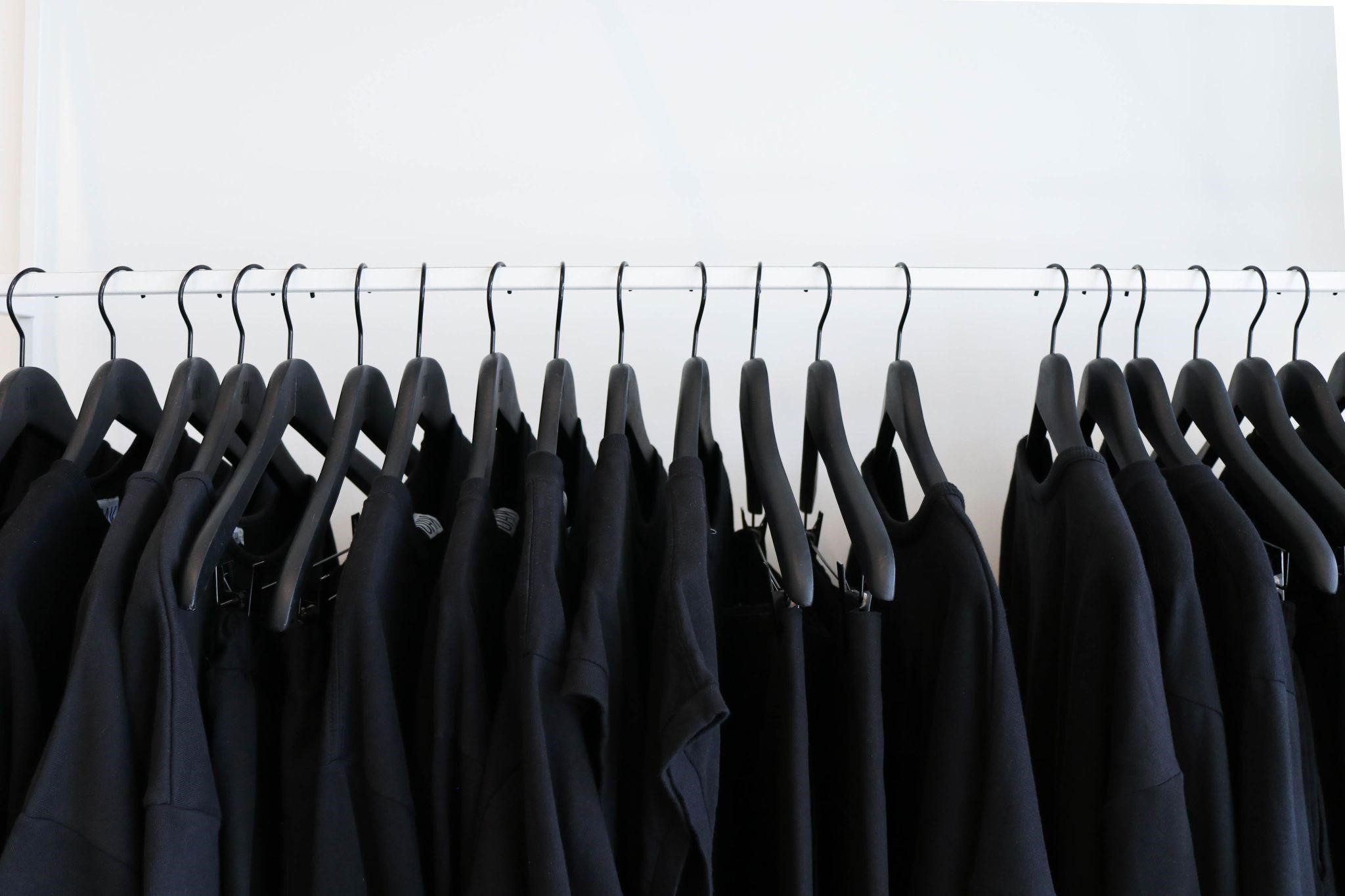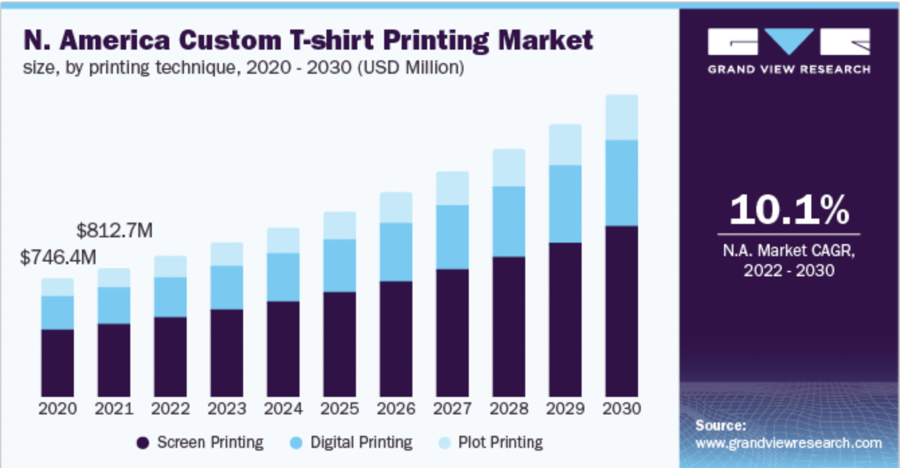
There was a time when screen printing was the overwhelmingly favored form of printed t-shirt production for businesses. But now DTG is becoming increasingly popular, particularly with Etsy and other small online shop owners who recognize its many benefits to them.
What is DTG? How is it different from screen printing? Which approach is better for selling t-shirts online? We will dive into these topics today and give you in-depth information about these printing styles.
What is DTG Printing?
DTG is short for Direct to Garment. This production method has been commercially available for less than 20 years and is still only offered by a relatively small number of printing companies.

Source: ASI
DTG uses a digital print head to print designs directly onto the fabric or surface of your choice. Printers used for DTG range widely from home desktop-type models to climate-controlled units. When printing fabrics, the ink goes directly into the fibers.
While with other print methods, you can feel the design when touching it. However, with DTG, this is not the case. Some people prefer prints you can feel and touch, while other potential customers appreciate this sense that the artwork is embedded inside the garment.
However, these factors aside, there are a lot of advantages and disadvantages to using or not using DTG printing that eCommerce entrepreneurs should first consider before launching their online t-shirt business.
What are the Advantages of DTG Printing?
Naturally, DTG printing comes with many advantages over alternatives. Let’s break them down.
1. Flexible Fulfillment
DTG is possible for both mass production and small production runs. This flexibility makes life much easier for budding online business owners. Because DTG doesn’t need to be ordered in bulk, you can fulfill orders on-demand. When working with a DTG supplier that offers print-on-demand, your business won’t need to front the costs of materials or equipment before making your first sale.
2. More Available Colors
DTG printing can support a broad range of color options to help make any product stand out from the crowd. If you’d like to print full-color designs on your shirts with intricate details, DTG is the way to go. Photographs and illustrations especially shine in this style of printing.
3. Better Comfort & Feel
Because DTG printing uses thin, water-based ink that absorbs into the fabric, rather than sitting on top of the material, the resulting garments are much more breathable. The fabric also feels more flexible and soft, which customers may prefer.
4. Eco-Friendly Printing
Compared to screen printing, DTG is the more sustainable printing method. This is because shirts do not need to be made in bulk — your business can create shirts one at a time as they’re ordered, reducing waste. Modern DTG printers also produce less wastewater.
Apart from this being good for the planet, eco-friendly business practices are also something many potential customers are demanding in 2022. Global trends show that an eco-friendly printing product will be increasingly favored over traditional screen-printed apparel.
5. Higher Quality
Not only can DTG printing produce a more colorful image on a t-shirt, but the print itself can be much more intricate. This is why many DTG print designs are complex with various small details — they would be difficult to achieve with screen printing.
What are the Disadvantages of DTG Printing?
Unfortunately, there are also a few disadvantages that come with DTG printing.
1. Expensive in Mass Production
Most of the advantages of DTG are for smaller-scale production. If your t-shirt business needs a cost-effective garment printing solution for bulk ordering and mass production, then DTG may not be the right method for you. This isn’t to say that it’s impossible to order DTG printed shirts in bulk — it just may not be the most affordable option.
2. Limited Garment Colors
Unfortunately, DTG makes it difficult to achieve on garments that aren’t white. When DTG printing onto darker fabric, prints may not appear as clearly or correctly. If you’d like to sell darker shirts with printed designs, achieving high-quality DTG prints may not be ideal for your business.
3. Slower Production
If you are not interested in mass production, then the chances are that slower print speed than some alternatives won't be a factor for you. If speed matters, then DTG might not be ideal — especially if you’re working with a print-on-demand dropshipping service and not printing yourself.
4. Limited Design Placement
DTG design placement is typically limited to a small area on the front of a t-shirt. If your desired shirt designs include printing all over the front, back, and arms, then DTG printing won’t meet your production needs.
5. Cotton is Required
DTG is limited to cotton, which rules out this print method for many. This isn’t immediately a negative, as cotton is a wonderful product. It is comfortable, naturally sustainable, hypoallergenic, low maintenance, and odor-free.
However, if you want to sell printed t-shirts made out of other fabrics, DTG isn't the best option for your business.
What is Screen Printing?
Screen printing is the process of transferring a stenciled design onto a surface. This method is believed to date back thousands of years and has been with us as a popular form of commercial printing since the 18th century.

Source: Grand View Research
This process uses a mesh screen, ink, and a rubber blade. Once a stencil design is created on a mesh screen, the ink is pushed and imprinted onto the surface below. This method can be used on many different surfaces and with various colors.
Screen printing is sometimes called “silk screening” or “silkscreen printing.”
What are the Advantages of Screen Printing?
While DTG is ideal for many businesses, mainly small-scale online entrepreneurs, screen printing offers some excellent advantages for merchants worth considering.
1. Wide Print Versatility
Screen printing is ideal for your business if you want designs printed on a whole host of different surfaces and fabrics. This introduces a great deal of design freedom — and being able to print on almost any materials available is a big plus.
2. Better Profit Margins
Screen printing can be expensive to set up, making some small print runs unviable. However, screen printing quickly becomes cost-effective if printing in high volumes, offering increasingly favorable margins.
As is always the case, do your due diligence and work out your costs and profit margins before deciding which kind of production to move forward with.
3. Repetition & Efficiency
Screen printing is ideal for any business looking to sell repeat designs. Once you've set up the screen print, it can be utilized repeatedly. There is no loss in quality over time; in this sense, it also offers efficiency.
4. Higher Durability
Screen printing tends to mean more significant ink coverage than other methods. This, in turn, means a more durable printed design less likely to fade or suffer cracks or scratches. This factor is significant for clothes that require outdoor use in all conditions.
5. Trusted and Straightforward
There’s a reason that screen printing has been around for centuries and remains one of the most popular ways to print designs onto garments. It’s a reliable form of printing that has stood the test of time. In this regard, it is trusted and straightforward, and millions worldwide are familiar with it.
What are the Disadvantages of Screen Printing?
Just like DTG printing, screen printing has its own list of disadvantages. Here's what you should know.
1. Mass Production Shortcomings
Screen printing is often used for mass production. The danger with this form of production is that hundreds or thousands of items of stock are produced, which may remain unsold — wasting finite resources.
If you’re a small business just getting started, you may not want to start producing large quantities immediately. In this case, you will need to decide if smaller-scale DTG printing is better for your business than gambling on manufacturing lots of stock that may never sell.
2. Set-Up Time
While the actual time it takes to print a design on a garment is only a few minutes, creating and setting up a screen printer can take several hours. This is not cost-effective for small runs unless they are premium-priced. This is because garments produced in small quantities usually have high print setup costs, which factors into their price.
3. Less Sustainable
Screen printing is not the eco-friendliest production method out there. The product is often mass-produced, and screen printing uses significant amounts of water. Additionally, some of the inks used are not biodegradable. Even if these environmental concerns aren't important to you, they might be to your potential customers.
4. Disappointing End Results
Sometimes, screen printing can result in disappointingly blurred results. Unfortunately, printing a one-off sample to test quality isn't an option like it is with DTG. A screen print takes time and money to set up, so the design must be perfect before printing.
5. Color Limitations
Screen printing can become extremely expensive if you want to add several colors. It's often not ideal if you wish to add three or more colors to your designs. This is because you will need to separately print those colors on top of the other colors in your design, which can be time-consuming and costly. DTG is much more ideal for designs with a variety of colors.
Is DTG or Screen Printing Better for Your Online Business?
Most alternatives in life have their positives and negatives. When comparing DTG vs. Screen printing, this is most definitely the case. These are two of the most popular methods for customized apparel printing. Ultimately, what is better for you will depend on your requirements.
DTG is undoubtedly better suited for any online clothing shop that wishes to offer an array of designs that can be sold as and when the orders come in, rather than held as expensive stock that might never sell. On the other hand, screen printing will often suit businesses who wish to print in bulk and concentrate on the margins.
Fashion houses running small print quantities will tend to favor DTG, as will any business or organization that wants to produce garments for event product runs with small print runs.
When releasing new products and designs to market at low costs, DTG is ideal. Indeed, it is also suitable for “testing” the eCommerce clothing market with new ideas to see whether they have any potential.
DTG is also a greener alternative to most of the opposition out there, which might help define your business and enable it to stand out from its competitors.
The same goes for quality: highly detailed, high-quality DTG prints can also look better and cost less than the screen printing alternative.
Conclusion
As we have discussed, DTG and screen printing have many advantages and disadvantages.
When choosing which to use for your business, you must fully understand what your business is about and how these print methods can help grow or sustain what it is you are doing. In some instances, combining these types of print production might be a good option.
If you're starting an online store, chances are DTG will work better for you. It offers the flexibility you need while avoiding investing and holding large amounts of stock. However, if you own an enterprise-level business with the resources to spend on mass production, then screen printing may be your choice. In the end, you should make the decision that’s right for your business’s needs.





Leave a reply or comment below